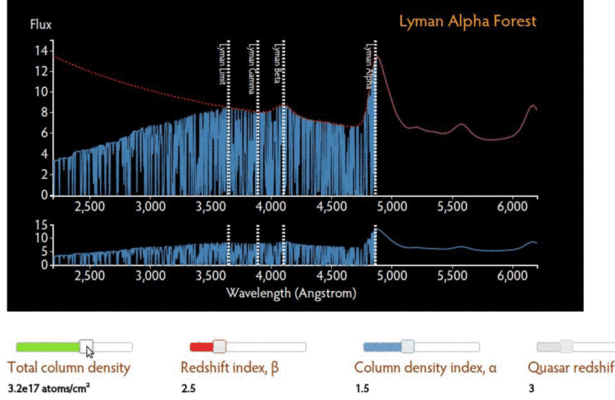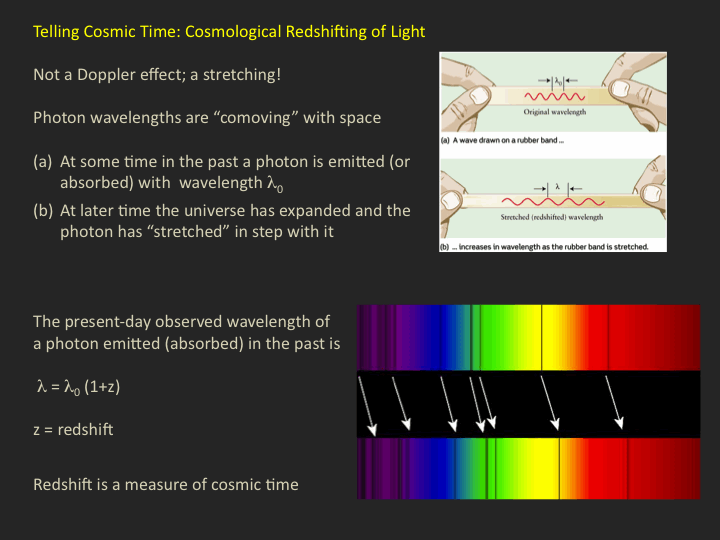

In effect the quasar sample is very much like a core sample, as if we were able to drill back in time to the quasar through the material that lies along the line of sight. The continuum longward of 1000 can be modeled as a power. There is a significant steepening of the continuum slope around 1000. The spectrum covers the wavelengths between 6 in the rest frame, with a peak S/N level of per. The intrinsic absorption lines of quasars are often thought to originate in the. We construct a composite quasar spectrum from 149 HST FOS spectra of 80 quasars with mean redshift. There are many lines, which is why the collection of clouds responsible for them is often called the Lyman-α Forest. Absorption lines are often observed on the quasar spectrum. The absorption occurs at a particular wavelength corresponding to the Lyman-α transition but, because the clouds are all at different redshifts, each produces a line at a different observed wavelength in the quasar spectrum.

The dark bands and lines you can see in the spectrum are caused by absorption of the light from the quasar by clouds of hydrogen gas between the quasar and the observer the strength of the absorption indicates how much gas the light from the quasar has travelled through. This quasar is an interesting object, at a redshift of z= 3.0932 (which converts to a look-back time of about 11.6 billion years). Here is an example (from here) which shows the light from the quasar HE0940-1050 taken by the UVES instrument mounted on ESO’s Very Large Telescope in Chile. But that’s not to say that spectra can’t be pretty either. In fact the rise of astronomical spectroscopy is what turned astronomy into astrophysics. Actually a large part of observational astronomy isn’t about making images of things but doing spectroscopy.
#Quasar spectra code
The code is highly flexible and can be modified to meet the specific needs of the user.Many people seem to think that astronomers spend all their time looking at pretty pictures of stars and galaxies. Absorption lines in intervening clouds along the line of sight of the QSO give access to the spectra of the atoms present in the cloud, that it is to paleo-spectra. For example, for some objects the UV/optical Fe II emission cannot be well constrained and the user may want to exclude this component in the continuum fit. Quasar (QSO) absorption lines provide a powerful probe of the variation of fundamental constants. Within the code, the user can switch on/off components to fit to the pseudo-continuum. An example of such a file is provided in the example.ipynb. In a spectrum of a distant galaxy, these same lines are observed to have wavelengths of 492 nm, 521 nm, 583 nm, and 787 nm respectively. Check Your Learning Several lines of hydrogen absorption in the visible spectrum have rest wavelengths of 410 nm, 434 nm, 486 nm, and 656 nm. The code uses an input line-fitting parameter list to specify the fitting range and parameter constraints of the individual emission line components. The quasar is thus receding from us at about 88 the speed of light. The code takes an input spectrum (observed-frame wavelength, flux density and error arrays) and the redshift as input parameters, performs the fitting in the restframe, and outputs the best-fit parameters and quality-checking plots to the paths specified by the user. Monte Carlo estimation of the measurement uncertainties of the fitting results can be conducted with the same fitting code. The package includes the main routine, Fe II templates, an input line-fitting parameter list, host galaxy templates, and dust reddening map to extract spectral measurements from the raw fits. The code is currently transferred from Yue's IDL to Python. We provide a brief guide of the Python QSO fitting code (PyQSOFit) to measure spectral properties of SDSS quasars.

PyQSOFit A code to fit the spectrum of quasar example.ipynb is a demo for the quick start !!!


 0 kommentar(er)
0 kommentar(er)
